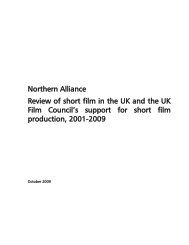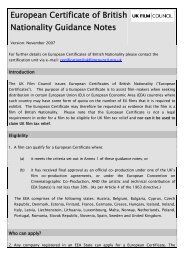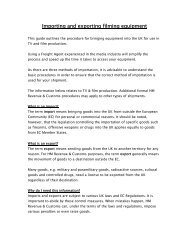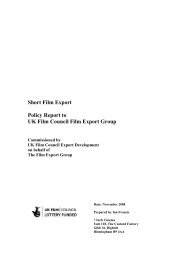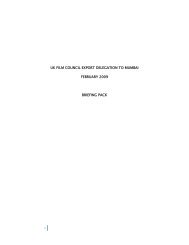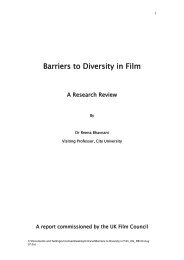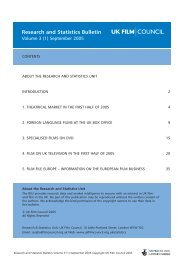Film theft in the UK - Future of Copyright
Film theft in the UK - Future of Copyright
Film theft in the UK - Future of Copyright
You also want an ePaper? Increase the reach of your titles
YUMPU automatically turns print PDFs into web optimized ePapers that Google loves.
22<br />
more than two weeks before its <strong>of</strong>ficial<br />
premiere whilst special effects on <strong>the</strong> movie<br />
were be<strong>in</strong>g completed. The critical pann<strong>in</strong>g <strong>of</strong><br />
<strong>the</strong> movie that followed on Internet chat sites<br />
was, accord<strong>in</strong>g to sources at Universal Studios,<br />
responsible for what it called a relatively poor<br />
$62.6 million open<strong>in</strong>g weekend <strong>in</strong> <strong>the</strong> US<br />
(which ironically was a record June open<strong>in</strong>g<br />
weekend). Notably, it was an open<strong>in</strong>g that was<br />
disappo<strong>in</strong>t<strong>in</strong>g enough to knock 12% <strong>of</strong>f Marvel<br />
Comics’ share value on <strong>the</strong> New York Stock<br />
Exchange.<br />
Sources <strong>of</strong> <strong>in</strong>ternet piracy<br />
The Hulk case highlighted ano<strong>the</strong>r significant<br />
issue. An <strong>in</strong>dividual <strong>in</strong>volved <strong>in</strong> market<strong>in</strong>g <strong>the</strong><br />
movie leaked <strong>the</strong> copy that found its way onto<br />
<strong>the</strong> Internet. The culprit was eventually tracked<br />
down by <strong>the</strong> FBI and prosecuted. But <strong>the</strong> affair<br />
cast light on <strong>the</strong> extent <strong>of</strong> leaks with<strong>in</strong> <strong>the</strong> postproduction<br />
and distribution process.<br />
Accord<strong>in</strong>g to a recent study 23 by AT&T Research<br />
and <strong>the</strong> University <strong>of</strong> Pennsylvania, over 77% <strong>of</strong><br />
all illegal movies on P2P networks are <strong>the</strong> result<br />
<strong>of</strong> ‘<strong>in</strong>sider leaks’. That is, employees<br />
somewhere along <strong>the</strong> filmmak<strong>in</strong>g cha<strong>in</strong> ripp<strong>in</strong>g<br />
and upload<strong>in</strong>g ‘screener’ copies <strong>in</strong>tended for<br />
non-commercial use. The AT&T study<br />
conducted an 18-month empirical analysis <strong>of</strong><br />
P2P fileshar<strong>in</strong>g networks, look<strong>in</strong>g for a random<br />
selection <strong>of</strong> film titles <strong>in</strong> <strong>the</strong> US box <strong>of</strong>fice top<br />
50 between 1 January 2002 and 27 June 2003.<br />
The result<strong>in</strong>g data, compiled from an eventual<br />
312 movies, were <strong>in</strong>terest<strong>in</strong>g. Of all films, 77%<br />
were sourced back to with<strong>in</strong> <strong>the</strong> filmmak<strong>in</strong>g<br />
and distribution process, as set out above.<br />
Accord<strong>in</strong>g to <strong>the</strong> same piece <strong>of</strong> research, over<br />
90% <strong>of</strong> movie content available on P2P<br />
networks is before <strong>the</strong> US DVD release.<br />
The AT&T listed <strong>the</strong> follow<strong>in</strong>g as po<strong>in</strong>ts <strong>of</strong> risk<br />
<strong>in</strong> <strong>the</strong> filmmak<strong>in</strong>g cha<strong>in</strong>:<br />
• Unauthorised copy<strong>in</strong>g <strong>of</strong> a movie <strong>in</strong> <strong>the</strong><br />
edit<strong>in</strong>g room or nearby <strong>in</strong> <strong>the</strong> supply cha<strong>in</strong>,<br />
whe<strong>the</strong>r first cut or f<strong>in</strong>al product. These copies<br />
<strong>of</strong>ten have small differences from <strong>the</strong> released<br />
version or <strong>in</strong>clude <strong>in</strong>complete audio or visuals.<br />
• Unauthorised copy<strong>in</strong>g <strong>of</strong> a critic’s advanced<br />
copy <strong>of</strong> a movie. This may have <strong>the</strong> text<br />
“Screener copy only, property <strong>of</strong> some name”<br />
appear<strong>in</strong>g on <strong>the</strong> screen occasionally.<br />
• Unauthorised copy<strong>in</strong>g <strong>of</strong> a promotional or<br />
preview screen<strong>in</strong>g copy. This may be marked <strong>in</strong><br />
a similar fashion to critics’ versions.<br />
• Unauthorised copy<strong>in</strong>g <strong>of</strong> an awards judge<br />
presentation <strong>of</strong> a movie. Copies may be marked<br />
with <strong>the</strong> text “For your consideration”.<br />
• Digital ‘through-<strong>the</strong>-air’ video record<strong>in</strong>g by a<br />
projectionist at a c<strong>in</strong>ema with aspect-correct<br />
video, suitable exposure, and direct audio.<br />
These copies have highly variable video quality,<br />
but can <strong>of</strong>ten be very good.<br />
• Unauthorised copy<strong>in</strong>g <strong>of</strong> a consumer<br />
medium such as DVD or VHS at <strong>the</strong> factory or<br />
any o<strong>the</strong>r po<strong>in</strong>t prior to sale. These copies are<br />
unmarked and <strong>of</strong> near perfect quality.<br />
The MPA has taken issue with <strong>the</strong> AT&T<br />
research, po<strong>in</strong>t<strong>in</strong>g <strong>the</strong> f<strong>in</strong>ger more squarely at<br />
<strong>the</strong> camcorder pirates <strong>in</strong> preview screen<strong>in</strong>gs,<br />
who are reckoned by <strong>the</strong> MPA to be responsible<br />
for 90% <strong>of</strong> all pirated films. Accord<strong>in</strong>g to <strong>the</strong><br />
MPA, <strong>the</strong> AT&T research is flawed because <strong>the</strong><br />
survey relied heavily on a s<strong>in</strong>gle, unnamed<br />
Internet portal to identify which films were<br />
onl<strong>in</strong>e and by conf<strong>in</strong><strong>in</strong>g <strong>the</strong>ir analysis to movies<br />
available 100 days after release, <strong>the</strong> researchers<br />
excluded <strong>the</strong> major source <strong>of</strong> onl<strong>in</strong>e piracy,<br />
namely camcords at <strong>the</strong>atrical screen<strong>in</strong>gs. This<br />
resulted <strong>in</strong> <strong>the</strong> exclusion from <strong>the</strong> analysis <strong>of</strong><br />
poor quality copies, primarily those deriv<strong>in</strong>g<br />
from use <strong>of</strong> camcorders <strong>in</strong> c<strong>in</strong>emas. Accord<strong>in</strong>g<br />
to <strong>the</strong> MPA, between May 2002 and May<br />
2003, over 50 major movie titles were stolen by<br />
camcord<strong>in</strong>g prior to <strong>the</strong>ir <strong>the</strong>atrical release <strong>in</strong><br />
<strong>the</strong> US. The MPA has also criticised AT&T’s<br />
def<strong>in</strong>ition <strong>of</strong> <strong>in</strong>dustry “<strong>in</strong>sider”, suggest<strong>in</strong>g it<br />
encompasses too broad a universe <strong>of</strong> people,<br />
<strong>in</strong>clud<strong>in</strong>g couriers, ad agencies and c<strong>in</strong>ema<br />
projectionists.



